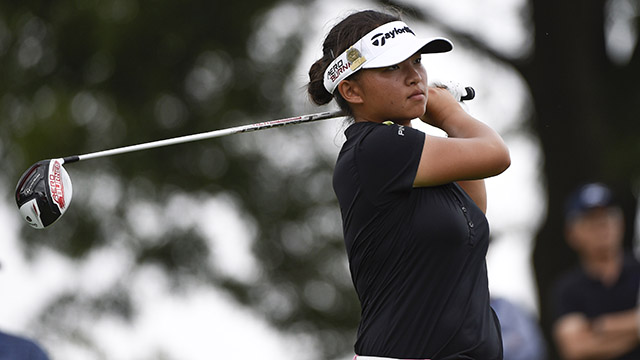NEWS
Teens becoming a force in women's golf

LANCASTER, Pa. -- Megan Khang, a 17-year-old who at 5-foot-1 wasn't much taller than the driver she leaned against on Lancaster Country Club's 10th tee, was leading the 70th U.S. Women's Open on Thursday morning.
One shot behind the Massachusetts high school senior at that moment were Lydia Ko, another 17-year-old who also happened to be the world's No. 2-ranked player, and Morgan Pressel, who at age 18 in 2007 became the youngest major winner in LPGA history.
On Friday, at nearly the same point in the second round, Khang had faded, but 16-year-old Muni He, a Chinese national transplanted to California, was tied for the 4-under lead.
Related: Yang maintains three-shot lead after third round of U.S. Women's Open
Though Jordan Spieth's Masters and U.S. Open victories have made him the wunderkind of men's golf at 21, he'd be a graybeard here. According to the United States Golf Association, 30 of this Open's 153 entrants are teenagers and the field's average age is just 25.
And far from just competing, several female teenagers have triumphed on the LPGA Tour in the last decade, something that has happened only twice in the PGA Tour's 86-year history, most recently when Spieth captured the 2013 John Deere Classic two weeks shy of his 20th birthday.
Ko won consecutive Canadian Opens at 15 and 16 and for a time was world No. 1. Lexi Thompson, who has attracted some of the largest crowds at LCC, qualified for her initial Open as a 12-year-old and won her first LPGA tourney at 16 and her first major at 19.
This youth movement resonates beyond the professional Tour. In 2014, 11-year-old Lucy Li qualified for the Women's Open, and this year Hannah O' Sullivan, a 16-year-old Arizonan, became the youngest winner ever on the women's developmental Symetra Tour.
"The girls just keep getting younger and younger," said Shannon Rouillard, a USGA executive. "There are just so many opportunities for girls now that I think this is going to be a trend that we see continue."
There are many reasons female teenagers are succeeding where their male counterparts aren't. Some are competitive, some are cultural and some, experts say, should be fairly obvious.
"The simple explanation is that women mature physically faster than men," said Greg Wells, a physical education and health professor at the University of Toronto who has researched the physiology of golf.
"A woman between 14 and 18 is more likely to have reached physical maturity than a boy of the same age. At a time when she's finished growing, a boy that age is still going through all that stuff with his testosterone and growth hormones."
Wells said a world-class golf swing incorporates virtually every muscle in the body, and even girls as tiny as Li was in 2014 -- 4-foot-11 and under 100 pounds -- are capable of the power explosion the professional game requires.
"You see it all the time, these little figure skaters and gymnasts just exploding into their jumps," Wells said. "It's the same thing in golf. Even small girls with small, compact swings can generate tremendous swing speed."
The phenomenon is also the result of another explosion, this one demographic.
Twenty years ago, when Rouillard began supervising the U.S. Women's Amateur, there were about 400 entries. This year, she said, more than 1,300 women and girls entered.
The same is true with the Women's Open. In 1996, 865 golfers attempted to qualify. This year that figure hit a record 1,873.
"And the average age of the four semifinalists at this year's Women's Amateur," Rouillard said, "was 15."
Because of its longer and more successful history, the PGA Tour has had a larger talent pool competing for its exemptions, making it tougher for younger men to break through. It's only recently that the LPGA pool has grown considerably deeper.
"I don't want to take anything away from the LPGA Tour," Rouillard said, "but the men's Tour has been tremendously competitive for a long time."
So alluring has the LPGA become for young golfers that Alison Lee surrendered a UCLA scholarship after her freshman year to compete on the Tour as an 18-year-old.
"With the girls getting younger and younger, it seemed like the right thing to do," Lee said. "I think there are real opportunities on our Tour for golfers of every age."
Many of the youngest phenoms on the women's side are, like Khang, Li and Lee, girls from Asia or of Asian descent. Female golfers from Thailand, China, Taiwan and especially South Korea were attracted to the sport in droves after South Korea's Se Ri Pak captured the Open in 1998.
"That was a huge moment," Rouillard said. "It created a real influx of young Asian girls."
When Li played at Pinehurst last summer at 11, some of her competitors were critical, believing that, no matter her physical gifts, a girl that age wasn't mentally equipped to deal with an Open's pressure.
"She qualified, so we can't say anything," Stacey Lewis said at the time. "But I like to see kids be successful at every level before they come out here."
Here at Lancaster, the youngest player is Japan's Suzuka Yamagichi, 14. She failed to make the cut after rounds of 73 and 76.
Whatever their motivation, this influx of young golfers is infusing the sport with new opportunities, new diversity, and new energy.
"I've said it before," Khang said Thursday, "but I think what we're seeing with all these young golfers is a new wave for the sport. And with so many of us around the same age, we don't feel so intimidated being out there any more."
This article was written by Frank Fitzpatrick from The Philadelphia Inquirer and was legally licensed through the NewsCred publisher network.
